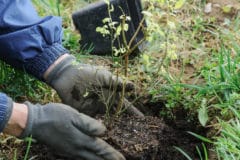Choose a Sunny Location
Find an area in your yard that doesn’t have overhanging trees. Trees not only provide too much shade to your blueberries, but they compete for soil nutrients and water. Too many trees around your blueberries also attract birds that will eat all the berries that you’ve worked so hard to grow. Your blueberries could also develop disease from trees that hinder air circulation. The best location is a wide-open area in full sunlight.
Blueberry Soil Conditions
Once you choose a sunny location, test your soil for pH readings. Blueberry bushes need well-drained, acidic soil that’s loose, rather than compacted. Make sure the soil drains well because blueberry roots can become damaged from standing water. The roots only grow up to 12 inches into the soil, and they can’t absorb nutrients through compacted soil.
Blueberries need a soil pH of 4.5 to 5.2 for the best growth. If your pH is too high, the will have slow growth and discolored leaves; eventually they will die. Depending on how your soil test turns out, you can supplement the soil with the nutrients it needs to meet pH requirements. An effective way to adjust the soil pH is to add 4 to 6 inches of peat moss to the soil.
Select Blueberry Cultivars
When you choose blueberry cultivars for your home garden, select at least two different varieties for cross-pollination. Bumblebees are the most common blueberry pollinators. When they carry pollen from one cultivar to another, larger berries grow. Also, if you choose cultivars that ripen at different times, you’ll have a longer blueberry picking season. The three most common types of blueberry are:
- Northern highbush
- Southern highbush
- Rabbiteye
Within each of these blueberry types are several different cultivars you can select.
Planting Blueberry Bushes
Once you have a sunny spot and the correct soil pH, it’s time to plant your blueberry bushes. If you’re new to growing blueberries, following these planting guidelines can help you get your young blueberry bushes established. You’ll have more success with your berries if you plant them in rows, rather than scattered around your garden or yard.
- Space the bushes 3-feet apart at the end of April or beginning of May.
- Dig a hole that’s big enough to fit the root ball and deep enough to cover the roots at the top with 4 inches of soil.
- Pack down the soil around the roots.
- Apply a 2 to 4 inch layer of mulch around the bush. You can use peat moss, sawdust, oak leaves or pine needles. These types of mulch are acidic, keeping the soil pH low.
- Water your new blueberry bushes, making sure it reaches the deepest roots.
Maintaining New Blueberry Bushes
For the first two years after planting your blueberries, don’t expect a crop of berries. In fact, what you want to do is prevent the bushes from producing berries, so the vegetation can grow and establish the plant. In the spring, when you notice flower buds forming, remove them by either rubbing or pinching them off with your fingers. If you let them develop into berries, your bushes will stop growing and become weak.
The goal is to let the blueberry bushes grow big and strong, so they can support a crop of berries. You can allow your blueberry bushes to bear berries after about three years. The bushes won’t reach their full growth for eight to ten years.
Ongoing Blueberry Bush Maintenance
Although wild blueberries do fine without maintenance, cultivated home-grown blueberry bushes need regular pruning, mulching and pest protection to promote new growth and berry production. Use the following checklist for maintaining your blueberries year after year:
- March – Prune your bushes after the last freeze and before new growth starts.
- April and May – Plant young bushes during this time.
- May and June – Apply organic mulch in a 15 to 18 inch circle around the bushes.
- July – Pick your blueberry crop.
- July to September – Make any adjustments to your soil pH using organic matter.
- September and October – Apply a layer of mulch to protect your bushes for the winter.
- November and December – Apply garden netting or fencing around your bushes as protection against rabbit and deer damage.
Blueberries need a lot of care and sunshine, but once you get into a routine, you’ll see that it’s all worth it. There’s nothing better than harvesting a pail full of fresh, sweet blueberries that you grew yourself. Keep your berries in the refrigerator, or you can freeze them in an airtight container for the longest shelf-life.












